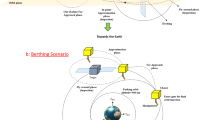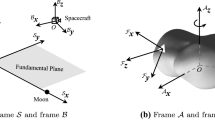Abstract
The Geometric method is one of the nonlinear methods for expressing the large-scale relative motion of satellites. In this paper, the equations of the Geometric method for perturbed orbits have been developed in the presence of third-body and \({J}_{2}\) gravitational perturbation. Then, these equations are employed for relative tracking and attitude control of two satellites to apply inter-satellite links. To validate the developed equations, the results obtained from these equations are compared to the main-body-centered-based relative motion (MCRM) model. Also, two control laws are designed to track and control the relative attitude of both satellites with consideration of external disturbances, the inertia uncertainty (due to fuel sloshing), and actuator saturation (due to bounded thrust). To establish inter-orbital links, it is necessary that the payload of satellites (the receiver and transmitter's antennas) are aligned in the same direction (named the reference trajectory). Due to the uncertainty in the attitude dynamics of systems and external disturbances, a robust controller must be applied to obtain control laws. The controller of the base satellite is designed so that the base satellite tracks the desired path (the reference trajectory) obtained from the relative motion equations. Furthermore, simultaneously and continuously, the target satellite control system tracks the base satellite antenna. For this reason, the external disturbances imposed on the base satellite affect the tracking control system of the target satellite. Also, a new definition of modified Rodrigues parameters (MRP) vector is proposed to design the tracking controllers that improve the control effort and convergence rate for the application of the inter-satellite links. Finally, two appropriate control laws for two satellites are designed through sliding mode control (SMC) theory subject to actuator saturation, inertia uncertainties, and external disturbances.

























Similar content being viewed by others
References
Bakhtiari M, Daneshjou K, Abbasali E (2017) A new approach to derive a formation flying model in the presence of a perturbing body in inclined elliptical orbit: relative hovering analysis. Astrophys Space Sci 362(2):36
Schütze D (2016) Measuring Earth: current status of the GRACE follow-on laser ranging interferometer. In: Journal of Physics: Conference Series. vol 716. IOP Publishing, p 012005
Benzi E, Troendle DC, Shurmer I, James M, Lutzer M, Kuhlmann S (2016) Optical Inter-Satellite Communication: the Alphasat and Sentinel-1A in-orbit experience. In: 14th International Conference on Space Operations. p 2389
Laux O, Poncet D, Mager R, Schoenherr K (2012) Status of the European data relay satellite system. In: International Conference on Space Optical Systems and Applications (ICSOS)
Li Q, Yuan J, Zhang B, Gao C (2017) Model predictive control for autonomous rendezvous and docking with a tumbling target. Aerosp Sci Technol 69:700–711
Wiltshire R, Clohessy W (1960) Terminal guidance system for satellite rendezvous. J Aerosp Sci 27(9):653–658
Li P, Zhu ZH (2018) Model predictive control for spacecraft rendezvous in elliptical orbit. Acta Astronaut 146:339–348
Tschauner J, Hempel P (1965) Rendezvous zu einem in elliptischer Bahn umlaufenden Ziel. Astronautica Acta 2:802
Wang Y, Ji H (2019) Integrated relative position and attitude control for spacecraft rendezvous with ISS and finite-time convergence. Aerosp Sci Technol 85:234–245
Lee SS (2009) Dynamics and control of satellite relative motion: designs and applications. Dissertation, Virginia Tech
Wertz JR (2001) Mission geometry: orbit and constellation design and management: spacecraft orbit and attitude systems. Springer, Netherlands
Vadali SR (2002) An analytical solution for relative motion of satellites. In: Proceedings of the Fifth International Conference on Dynamics and Control of Structures and Systems in Space. pp 1–8
Alfriend K, Yan H (2002) An orbital elements approach to the nonlinear formation flying problem. In: International Formation Flying Symposium. Toulouse, France
Bakhtiari M, Daneshjou K, Fakoor M (2017) Relative hovering analysis about an elliptical perturbed orbit with consideration of dynamic air drag and oblate earth. Aerosp Sci Technol 70:286–299
Horri NM, Kristiansen KU, Palmer P, Roberts M (2012) Relative attitude dynamics and control for a satellite inspection mission. Acta Astronaut 71:109–118
Lu K, Xia Y (2013) Adaptive attitude tracking control for rigid spacecraft with finite-time convergence. Automatica 49(12):3591–3599
Gao J, Cai Y (2015) Fixed-time control for spacecraft attitude tracking based on quaternion. Acta Astronaut 115:303–313
Cao X, Wu B (2015) Indirect adaptive control for attitude tracking of spacecraft with unknown reaction wheel friction. Aerosp Sci Technol 47:493–500
Wu Y-H, Han F, Zheng M-H, Wang F, Hua B, Chen Z-M, Cheng Y-H (2018) Attitude tracking control for a space moving target with high dynamic performance using hybrid actuator. Aerosp Sci Technol 78:102–117
Golzari A, Pishkenari HN, Salarieh H, Abdollahi T (2020) Quaternion based linear time-varying model predictive attitude control for satellites with two reaction wheels. Aerosp Sci Technol 98:105677
Hakima H, Emami MR (2020) Concurrent attitude and orbit control for Deorbiter CubeSats. Aerosp Sci Technol 97:105616
Bohlouri V, Khodamoradi Z, Jalali-Naini SH (2018) Spacecraft attitude control using model-based disturbance feedback control strategy. J Braz Soc Mech Sci Eng 40(12):557
Alfriend K, Vadali SR, Gurfil P, How J, Breger L (2009) Spacecraft formation flying: Dynamics, control and navigation. Elsevier, Hoboken
Curtis HD (2013) Orbital mechanics for engineering students. Elsevier, Hoboken
Xu M, Wang Y, Xu S (2012) On the existence of J 2 invariant relative orbits from the dynamical system point of view. Celest Mech Dyn Astron 112(4):427–444
Lee D (2017) Nonlinear disturbance observer-based robust control of attitude tracking of rigid spacecraft. Nonlin Dyn 88(2):1317–1328
Wei C, Park S-Y, Park C (2013) Linearized dynamics model for relative motion under a J2-perturbed elliptical reference orbit. Int J Non-Linear Mech 55:55–69
Sidi MJ (1997) Spacecraft dynamics and control: a practical engineering approach. Cambridge University Press, Cambridge
Slotine J-JE, Li W (1991) Applied nonlinear control. Prentice hall, Englewood Cliffs, NJ
Bakhtiari M, Daneshjou K, Fakoor M (2017) Long-term effects of main-body’s obliquity on satellite formation perturbed by third-body gravity in elliptical and inclined orbit. Res Astron Astrophys 17(4):039
Author information
Authors and Affiliations
Corresponding author
Additional information
Technical Editor: Jader Barbosa Jr.
Publisher's Note
Springer Nature remains neutral with regard to jurisdictional claims in published maps and institutional affiliations.
Rights and permissions
About this article
Cite this article
Zarei, S., Bakhtiari, M. & Daneshjou, K. Relative attitude tracking of two satellites in the presence of third-body perturbation and considering actuator saturation. J Braz. Soc. Mech. Sci. Eng. 43, 545 (2021). https://doi.org/10.1007/s40430-021-03267-z
Received:
Accepted:
Published:
DOI: https://doi.org/10.1007/s40430-021-03267-z




